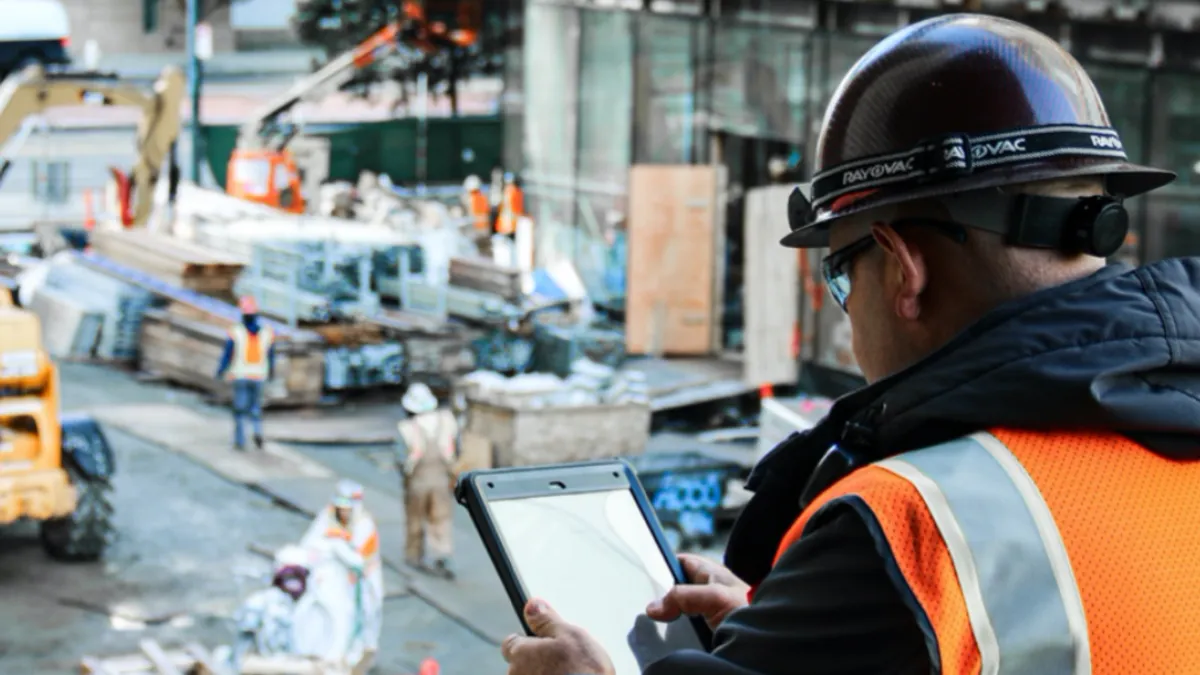In 2017, LafargeHolcim, one of the world’s largest suppliers of construction materials, tasked digital manager Jeff Chen with leading a 10-person team on a year-long, worldwide search for common construction woes that could be remedied by innovative technology.
Team members spent time with hundreds of AEC pros, learning their pain points. And at jobsite after jobsite, country after country, they saw how high-tech planning devolved into antiquated execution in the field. Nowhere was this more pronounced than in delivery management. Even on half-billion-dollar projects with dozens of subcontractors, the scheduling of hundreds of trucks every week was being coordinated on whiteboards and paper. Adding to the commotion, they found that 30% to 40% of the deliveries were unscheduled.
“All of that just can’t be managed manually,” Chen says.
The disarray inevitably led to late and unscheduled deliveries, long lines at entry gates and frustrated subcontractors. Beyond frazzling nerves, the disorganization was wasting time and money. Chen and his team saw that superintendents needed a real-time tool that could alleviate the chaos through collaboration. And so StruxHub was born.
Available nationwide, the app provides an online system for booking material and equipment deliveries to a jobsite. Launched early last year, it empowers subcontractors to schedule their own deliveries without relinquishing control from the general contractor.
“Our goal is to change the nature of how you coordinate,” says Chris Schmidt, who cofounded StruxHub with Chen.
Crowdsourced deliveries
With StruxHub, subs access a shared calendar, where they can view all scheduled and even pending requests for deliveries and reserve a time, offloading zone and equipment needed to get their materials on-site. All the GC has to do is approve each request.
“It enables us to crowdsource it out to the subs,” says Justin Porter, director of construction technology and innovation at Truebeck Construction. Chen and Schmidt partnered with the West Coast general contractor early on to refine the app and implement it at several of Truebeck’s jobsites, including Uber’s new 450,000-square-foot headquarters in San Francisco.
Located in the booming and congested Mission Bay neighborhood, the Uber campus is located near about 10 other active construction sites. Staging trucks on the street simply isn’t an option, so trucks often were sent circling back to the freeway – creating traffic snarls and delays that could contribute to cost overruns.
And then there was the cost of managing deliveries for a mammoth endeavor such as this: full-time dockmasters, foremen, flagmen and a superintendent determining priorities and, too often, breaking up disputes between subcontractors needing materials. Project engineers and managers, who should be out in the field, also have to take time away from their assigned job duties to coordinate the deliveries.
With StruxHub, even before a truck reaches the site, the app helps direct traffic – alerting vendors when a delivery is scheduled or rescheduled, for example, so they can reorganize their fleet, or blocking out deliveries at gates when there will be a conflict such as concrete being poured, Porter notes.
Both drivers and vendors can access detailed delivery information, including maps of the jobsite, entry gate and lay-down zone, as well as a scannable QR code to show the gate keeper.
And while StruxHub pushes notifications to users when a delivery is changed, scheduled, on-site, inspected or completed, Chen and Schmidt were careful to build in controls so that messages are only received by those specific workers who need to know.
“We didn’t want to spam everyone on the jobsite,” Schmidt says.
High confidence
After introducing StruxHub, the number of unplanned deliveries on Truebeck projects plummeted to just 1 percent. And with less chaos at the gates, even a massive project can operate with just one dockmaster and no flagmen, Chen says.
For subs, StruxHub streamlines the coordination required to get their materials on-site — delivering a lot less confusion and a lot more productivity.
“The subs now have high confidence that their material is going to get to them as needed,” Chen says.
In addition, deliveries can be scheduled without coming on-site, and can be booked further into the future than a whiteboard would allow, Schmidt says.
All the consideration that Chen and Schmidt put into the design of StruxHub Deliveries seems to be paying off. The app was adopted across several Truebeck sites, including a Facebook office in Silicon Valley, in a matter of months. It’s served over 12,000 trucks, and more than 10 jobsites are currently using the platform to schedule deliveries.
Engineers and managers are freed to focus on “high-value” work, Chen says. And tradesmen like carpenters “don’t have to be on the computer trying to manage all these deliveries. It gives us more time to build,” Porter says.






















